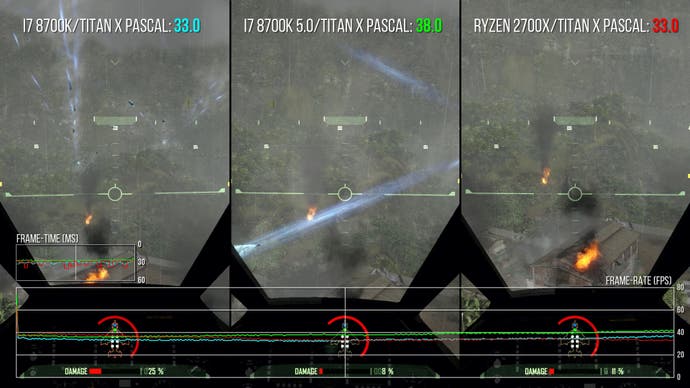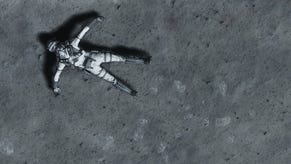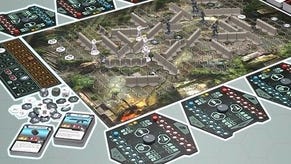Why Crysis still melts the fastest gaming PCs a decade after release
It's time for a remaster, remake - or sequel.
It's been ten years since Crysis first released on PC. In 2007, it pushed real time rendering to new heights and spawned the memetic phrase, "but can it run Crysis?". Never had a game released that pushed hardware and engine technology so much, and never has one since. In fact, combine the latest and greatest Intel Core i7 8700K overclocked to 5.0GHz with an Nvidia Titan Xp and there'll still be areas of the game that drop beneath 60fps - even at 1080p. For its own very specific reasons, Crysis is still more than capable of melting the most modern, top-end PCs, but regardless, it remains a phenomenal technological achievement. It deserves a remaster at the very least, but a franchise of this standing really deserves a full next-gen sequel, with state-of-the-art rendering and back-to-basics gameplay.
But what made Crysis so groundbreaking - and perhaps so misunderstood - at the time of its release? In the video below, I play through the first level of the game, highlighting the strengths and weaknesses of its rendering - and it's this initial stage that was our first glimpse of the game back in 2007. Crytek released a demo of this area with a full level editor, where you could spawn weapons, entities and enemies that only show up later in the game. It was a short, but comprehensive showing of all of Crysis' systems and grandeur in one 1.8GB download.
The game started as it meant to go on. In the very first scene alone, there's a separable gaussian depth of field on foreground objects, soft z-feathered particles for the fog in between the alien stalactite structures, and even ray-marched volumetric lighting that is visible as the alien vessel opens up. From here we transition over to a shot of Raptor team's transport flying into the island and we are greeted with some subtle metallic sheen on the jet itself, and some quite gorgeous rendered volumetric clouds with permeability, back scattering, and even inner shadowing. Let's remember that this hails from the year 2007 of course, where most games still were relying on static skyboxes.
And then there was the character rendering - and bam, it's right in your face. At this point in time, Crytek knew that its character technology was way ahead of its contemporaries, so you get to appreciate it right away. Being a forward shading engine, Crysis uses a lot of bespoke shaders in multiple passes to achieve very specific materials. So character eyes and hair all use their own special shading model that tries to approach "realism". It's not physically-based materials like you see in modern games, but nonetheless, an attempt to give a similar effect.
This opening cut-scene also gives you a first glance at the game's extensive use of post-processing. Every character movement is exaggerated and weighted with a very high quality per-object motion blur, which has a great and subtle tail and rather low shutter speed, with many samples. On a high-end 8800 GTX at 1280x1024 resolution, that effect alone would consume 4ms of GPU time - a full 25 per cent of the frame-time required to hit 60fps. Suffice to say that not many PCs were going to be getting a stable 30fps at the highest settings.
From there on out, the game continues to throw high-end effects at you - like the impact on the ocean itself after your parachute fails, the water caustics based upon the surface normal and with a partially volumetric effect in the water volume itself and you also see the refraction above the water surface. As you swim around you can see your own feet and arms moving about you to communicate presence. And then there's the beach, where you get your first interactions with objects, pushed to an almost silly degree with turtles, twigs - and even people - available to pick up. This is at a time when environmental interaction in games was telegraphed by the objects just floating in front of your character as you move.
In spite of the level of realism in most of its materials for the 2007-era time period, Crysis does not use image-based lighting from cube maps, or other types of probes, for that matter. You won't see glass objects with cubemap reflections in them, for example. But as a result, the only real specular lighting that really occurs is that from direct forward light sources, like the sun or any other real world lights. Only Crysis 2 and the later re-release of Crysis on consoles would take advantage of image-based lighting to increase the plasticity of indirect lighting.
By just turning around as you move up the beach head, you can admire the dedication put into subtleties of rendering in the sky and vegetation. You can see screen-space crepuscular 'god' rays filtering through the leaves from the moon, causing a specular sheen to show on the waxy surface off the leaves, and permeating through to their back side. And edge-blend anti-aliasing system is deployed, giving an FXAA-like effect that only impacted vegetation.
Yes, Crysis was a heavy game on system resources and to this day it has a reputation that it was 'unoptimised'. Now, on the one hand, it was clear that Crytek took liberties with a platform that was, in effect, infinitely expandable across time with a view of technology catching up wth its design choices. As then-Crytek (now id software) rendering mastermind Tiago Sousa told us back in the day: "In Crysis 1 times, our attitude was, 'oh what the heck, what's one more additional full resolution FP16 target or a couple of full screen passes, let's just add it'... you can't take such a naive approach for consoles."

But on the other hand, performance tweaks were incorporated. True volumetric clouds at the beginning of the game gave way to texture billboards once you landed, while the first member of Raptor team you meet - Jester - carries about a flashlight with a simplified spotlight effect (which swaps back to a full volumetric effect in cutscenes). A modern Crysis game based on the latest CryEngine would do this rather differently and in a way that is more physically accurate. The current tech - and its off-shoot in Amazon's Lumberyard - support a frustum voxel fog, where lights and shadows cast through it. Every light is technically "volumetric" with no picking and choosing due to performance reasons; the cost is much more flat. There would be no need for fake god rays from the sun or moon, as those effects just happen naturally as part of the rendering pipeline.
Crysis is fully capable of a full 24 hour time of day lighting cycle, but the game has areas where the passing of time is linked to progress through the level, leading up to that famous moment where you overlook the harbour, tasked with taking out jamming equipment. Like the opening scene in the plane, there are so many of Crysis's graphical effects coming into play here: the ocean rendering, the atmospheric scattering simulation, the crepuscular rays from the sun, the back lighting on the trees, and the incredible view distances just filled to the brim with AI and AI creatures. And then there was the vegetation and trees, with their procedural breaking of branches right down to the twig level. Head down to the harbour, shoot an oil barrel and watch it leak based on where you shot it. There's a level of simulation here you just don't see any more in modern games - the focus has changed, as we've explained recently in our Far Cry tech retrospective.
Some rendering effects we saw in Crysis do still persist into present day titles. There's the debut of screen-space ambient occlusion (SSAO), along with a glorious showcase in parallax occlusion mapping, an effect that only really came into its own on the current-gen consoles. Essentially a way to fake geometric depth on a surface, the game also supports shadows being cast from the parallax maps back on to themselves. POM only really gained momentum in the current-gen era and most games either just have parallax occlusion maps with no shadows, or just with shadows from one light source. It illustrates just how far ahead of the curve Crysis was, and while the game was indeed very heavy on GPU resources, that wasn't exactly unreasonable based on the quality of the visuals it was generating. The team's 'Maximum Game' ethos also saw them eschewing rendering shortcuts that would display artefacts in motion - Crysis looked amazing both in still shots and video.
And part of Crysis's reputation for melting cutting-edge hardware comes from all of those effects, framebuffers and high resolution textures, which made the title consume a lot of VRAM. GPUs of the era tended to top out at 512MB, and running the game on very high settings could see that limit easily surpassed - with parallax occlusion mapping in particular sucking up a lot of memory. Unless you had a 768MB card like the 8800 GTX, the chances are that the experience would stutter as data flowed in and out of VRAM into system memory. Had tools like Riva Tuner Statistics Server been available then, the chances are we would have seen more tweaks to texture settings and fewer complaints online.
But Crysis also hails from an era where the future of CPU technology was heading in a very different direction than Crytek may have originally envisaged. It is multi-core aware to a certain extent - gaming workloads can be seen across four threads - but the expectation for PC computing, especially from Intel with its Netburst architecture, was that the real increase in speed in computing would happen from massive increases in clock speed, with the expectations of anything up to 8GHz Pentiums in the future. It never happened, of course, and that's the key reason why it is impossible to run Crysis at 60fps, even on a Core i7 8700K overclocked to 5GHz. At its nadir in the Ascension stage (sensibly removed from the console versions), the fastest gaming CPU money can buy struggles to move beyond the mid-30s.
In intense, physics-driven firefights with a lot of enemy AI, you can also expect frame-rates to struggle. The Intel chip keeps you north of 60fps a lot of the time, but we were surprised to see how much the new Ryzen 7 2700X struggles to maintain 60fps in the heavier scenes - even with its XFR tech working exactly as it should, propelling the active cores to a max 4.3GHz. And it's here where the case for a proper Crysis remaster can start to be made. In fact, it already has been made - it was just never released for PC, instead arriving on Xbox 360 and PlayStation 3.
There are many, many cutbacks to the game (though it does retain parallax occlusion mapping and many other effects more suited to the current generation) and performance - to be frank - can be terrible. But it arrived after the more console-friendly Crysis 2, and the jobs-based CPU scheduling - which spreads tasks across Xbox 360's six threads and PS3's six available SPUs - would surely provide a revelatory increase in speed on modern PCs. In an ideal world, we'd love to see a Crysis Trilogy remaster or even a remake with all-new assets. However, the CryEngine of that era was built with multi-platform development in mind. In producing a PS3 and Xbox 360 version, in theory, a PC version would have been created in tandem. The idea of this version existing but not being available has been hugely frustrating for us across the years.
Yes, Crytek's extravagance with GPU resources means that some nips and tucks are required to run the game maxed on 1080 Ti-level GPUs at 4K60 - but by and large, graphics-wise, we're there. But owing to the more single-threaded nature of the CPU side of the equation, a locked 60fps Crysis experience will likely never happen, unless a port to a more modern CryEngine eventually appears. And the fact that the franchise has been left to rot generally is also upsetting, because we can see from the latest CryEngine just how stunning an entirely new Crysis could be.
It starts with vegetation, a signature element of the classic Crysis experience. Take a look at Ryse or more recently, Kingdom Come Deliverance and you'll see lush environments with much more accurate shadowing and denser placement, really communicating that 'jungle feel'. Lighting in the latest CryEngine can look simply beautiful and the most recent version features a form of sparse voxel octree global illumination, where the world objects are represented in a simplified form by a voxel grid, so expensive indirect lighting and shadowing maths can be done more quickly. In this case, it supports large scale ambient occlusion and secondary light bounces that update in real time. So you can imagine all the indirect lighting in some theoretical future Crysis jungle, where breaking down trees would also change colour, tonality and the direction of indirect lighting in that scene.
The technology is there, and the reputation of the franchise - despite the reception to Crysis 2 and its sequel - remains untarnished. This is a series that still defines the state of the art even now, and despite its PC roots, it would be a game that could make one hell of an impact as a launch title, heralding the arrival of a new console generation. But just a PC release of the last-gen console ports could see a resurgence of interest in this remarkable game, lowering the GPU threshold and potentially removing the CPU-bound limitations that plague the game until this day. Ten years on, Crysis remains a hugely influential title - and to be frank, a brilliant game. We hope to see its return one day.




















